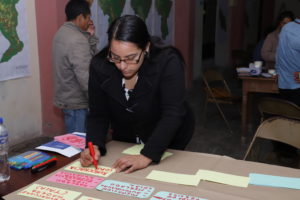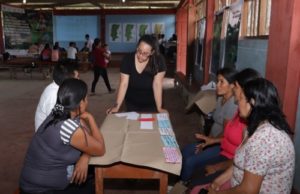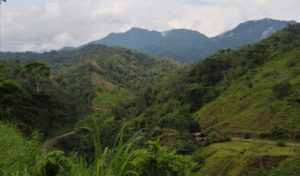Towards reducing deforestation in the Peruvian Amazon
In October 2018, Professors Anthony Bebbington and Denise Humphreys Bebbington visited the Universidad Nacional Toribio Rodríguez de Mendoza (UNTRM) in Chachapoyas, Perú to meet with faculty and university leaders and to give a public talk. That visit, related to research linked to the new Clark Center for the Study of Natural Resource Extraction and Society, led to a follow-up visit to Clark by Dr. Maria Fernandez of the UNTRM. When Dr. Fernandez was at Clark, we discussed possible future collaborations between the two universities around themes of indigenous knowledge, land use, resource extraction, and climate change. These are topics that have been discussed within NEC, and on which a team of Clark faculty, graduate and undergraduate students recently completely an extensive series of research reports for the Climate and Land Use Alliance. The field note below by Karen Canales Del Castillo, a graduate student in the Department of International Development, Community and Environment, grew directly from these exchanges between Clark and UNTRM. We hope that it will be a basis for future student and faculty collaborations.
August 5, 2019
 My name is Karen Canales Del Castillo and I am a second year IDSC student at Clark University. In the summer of 2019, I had the opportunity to intern at an international project in Amazonas, Peru thanks to Dr. Denise Bebbington who connected me with Dr. Maria Fernandez. I interned as a Stakeholder Analyst Assistant with the Amazonas regional team of the international project “Low Emission Rural Development, a participative strategy to reduce the deforestation in the Peruvian Amazon.” This project is being financed by the Norwegian Government through the United Nations Development Program (UNDP), it aims to strength the capacities of the Amazonas Regional government, indigenous communities and local municipalities to build a tool that would allow them to manage the jurisdiction of promoting low-emission development, increasing the production and reducing the deforestation. Some of the organizations involved in the Amazonas regional team arePeruvian Association for the Conservation of Nature (APECO), Nature & Culture International (NCI), Earth Innovation Institute (EII) and World Agroforestry (ICRAF).
My name is Karen Canales Del Castillo and I am a second year IDSC student at Clark University. In the summer of 2019, I had the opportunity to intern at an international project in Amazonas, Peru thanks to Dr. Denise Bebbington who connected me with Dr. Maria Fernandez. I interned as a Stakeholder Analyst Assistant with the Amazonas regional team of the international project “Low Emission Rural Development, a participative strategy to reduce the deforestation in the Peruvian Amazon.” This project is being financed by the Norwegian Government through the United Nations Development Program (UNDP), it aims to strength the capacities of the Amazonas Regional government, indigenous communities and local municipalities to build a tool that would allow them to manage the jurisdiction of promoting low-emission development, increasing the production and reducing the deforestation. Some of the organizations involved in the Amazonas regional team arePeruvian Association for the Conservation of Nature (APECO), Nature & Culture International (NCI), Earth Innovation Institute (EII) and World Agroforestry (ICRAF).

Participatory workshop in the Nieva District, Condorcanqui Province, Amazon Region
The first phase of the project, managed mainly by APECO, involved conducting five 3-day participatory workshops in the three provinces of the Amazon Region with the biggest deforestation rates, Bagua, Condorcanqui and Rodríguez de Mendoza. The objective of these participatory workshops was to determine the causes of the deforestation through a rigorous methodology named DRIVE NET created by the World Agroforestry Centre. There were two types of participatory workshops, one with only indigenous stakeholders, and another one with indigenous and non-indigenous stakeholders (multi-stakeholders). Among my duties, I assisted the ETA in finalizing the list of indigenous stakeholders of the provinces of Bagua and Condorcanqui where we were mainly working with the indigenous communities. Specifically, I was assigned in contacting female indigenous leaders since there were not initially included in the first stakeholder list. This was a complicated process due to communication challenges such as minimum access to phone and internet services of some indigenous communities’ members. Also, at the participatory workshops, I assisted the participants with some of the activities that were part of the methodology DRIVENET. For the final product of my internship, I am writing a practitioner paper to explore and analyze the gender interactions between women indigenous leaders in the indigenous participatory workshops and in the multi-stakeholder participatory workshops.

Multi stakeholder participative workshop in districts of San Nicolas, the province of Rodriguez de Mendoza, Amazon region
Overall, I had an amazing experience at the internship, especially during fieldwork. The ETA and I traveled back and forth from the city (Province of Chachapoyas) to the site of the participatory workshops (Province of Condorcanqui and Bagua) for over a month. Each trip, in ideal weather conditions, took around 8 to 10 hours driving (one-way). As a result, the team and I spent a lot of time on the road. During this time, I was able to notice the extent of deforestation around us. Even though I was aware of the increasing deforestation rates located closer to roads, I did not fully understand the diversification of the deforestation drivers.
Perhaps, the picture below shows some of the different deforestation drivers. In the far-right corner of the picture, you can see a few cows, this speaks for farming practices. Farming, in the province of Condorcanqui, is unusual and somewhat new. During the participatory workshops with the indigenous communities, some participants explained that migrants from the Peruvian sierra were moving to this province to carry out their farming practices. In fact, in Peru, farming is mainly practice in the sierra. In the case of the Amazon region, farming in mainly practice in the province of Rodriguez de Mendoza and is the main deforestation driver in the area. Thus, the growing practice of farming in the province of Condorcanqui presents a major danger to combat deforestation. Similarly, in the middle of the picture (the triangle shaped area) there is deforestation caused by bamboo plantations. From the results of the participatory workshops, bamboo plantations were shown to be one of the predominant deforestation drivers throughout the province of Condorcanqui.
 However, is very important to knowledge that I am only describing some of the direct causes of deforestation. Both, farming and bamboo, have a complex socio-environmental context (indirect causes) such as economic instability, lack of environmental policies enforcement, among others. Indeed, the description of the deforestation drivers does not aim to find who is guilty, but instead to understand that there is a complex reality behind deforestation and that it is very important to become educated about these issues. Especially now that climate change is an alarming concern that requires actions—not just any actions, but well-informed actions.
However, is very important to knowledge that I am only describing some of the direct causes of deforestation. Both, farming and bamboo, have a complex socio-environmental context (indirect causes) such as economic instability, lack of environmental policies enforcement, among others. Indeed, the description of the deforestation drivers does not aim to find who is guilty, but instead to understand that there is a complex reality behind deforestation and that it is very important to become educated about these issues. Especially now that climate change is an alarming concern that requires actions—not just any actions, but well-informed actions.
Karen Canales Del Castillo, IDSC
I would like to express my gratitude to all the people who helped through the process of completing the internship in Chachapoyas, Amazonas. Thank you Dr. Bebbington for allowing me to be part of this amazing professional opportunity and helping me to get in contact with Dr. Fernandez. Thank you, Dr. Fernandez, for hosting me in your home (in Chachapoyas) and supporting me through the entire internship. Thank you to the Amazonas regional team specially to Keith, Humberto, Jorge and Diorman, from whom I was able to learn so much during my three months at the internship. Lastly, but not least, thank you to the Peruvian Association for the Conservation of Nature (APECO) for allowing me to be part of this project.
